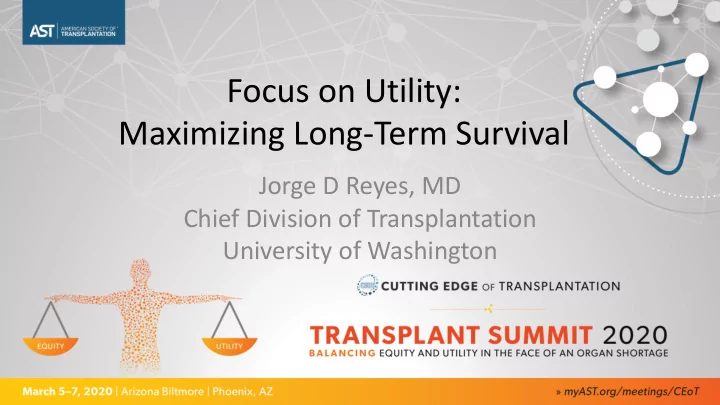

Focus on Utility: Maximizing Long-Term Survival Jorge D Reyes, MD Chief Division of Transplantation University of Washington
Disclosure I have nothing to disclose.
Learning Objectives 1. Become aware of optimization techniques for organ allocation 2. Understand constraint of quality of liver organs for transplantation 3. Review the concept of futile liver transplant
Maximizing Long-Term Survival • Approach – Machine Learning(ML) • Optimization* – ML technique to find the best possible solution for a given problem for all possible solutions – Rigorous mathematical model to determine the most efficient solution to a described problem » Linear, Quadratic or Non-Linear Programming *Optimization Using R, KDnuggets May 2018, by Perceptive Analytics
Steps of Optimization • Define Problem – Objective • Minimize • Maximize • Resources • Constraints
Optimization For Liver Allocation Objective: Matching Donors with Recipients to Optimize Graft • Survival Resources • – Donor – Recipients Constraints • – Shortage of Donors – Quality of Donors and Recipients – Others • Timing • Laws/Regulations
Data for Optimization • OPTN Data Supplied by UNOS – 1/1/2008 to 12/31/2012 • Candidates’ Waiting List • Transplanted Recipients
Donor Risk ( Cox Hazard Model) * * Reyes JD et al, Size mismatch in deceased donor liver transplantation and its impact on graft survival, Clin Transplant 2019 Aug;33(8):e13662. doi: 10.1111/ctr.13662. Epub 2019 Jul 26.
Distribution of Donor Risk Relative Risk of Liver Donors
5 Donor Risk Groups
Survival by Donor Risk Groups
Recipient Risk (Cox Hazard Model)
Distribution of Recipient Risk
5 Recipient Risk Groups
Survival by Recipient Risk Groups
5 Donor Groups and 5 Recipient Groups (25 Combinations for survival analysis)
Optimization Analysis: Patient Waiting List and Donors Available Years 1/1/2008 to 12/31/2012 Patient Donor Groups (N=66351) (N=30284) 1 3133(4.7%) 3057(10.1%) 2 11436(17.2%) 5156(17.0%) 3 36821(55.5%) 3239(10.7%) 4 11387(17.2%) 12005(39.6%) 5 3574(5.4%) 6827(22.5%)
Survival of 25 Donor_Recipient Risk Groups D_R 1_1 and 2_1 best survival D_R 4_5, 5_4 and 5_5 worst survival
Eliminating Poor Survival Combinations Eliminate Group 5 Candidates Eliminate Group 5 Donors to Group 4 Candidates Eliminate Group 5 Donors to Group 1 Candidates (many 1A)
Optimization Allocation Rules Resulting in Best Long-term Graft Survival Satisfying Constraint of Donor Shortage and Donor and Recipients Risk • 1. Group 1 donors used only for Group 1 recipients. • 2. Group 2 donors used for Group 1 and 2 recipients • 3. Group 3 donors used for Group 2, 3, and 4 recipients • 4. Group 4 donors used for Group 2, 3, and 4 recipients • 5. Group 5 donors used for Groups 2 and 3 recipients
Results of Optimization Analysis Allocation
Re-Transplant Rate Transplants 1/1/2008 to 12/31/2012 Total Transplants N= 30284 Grafts Not Actual Ideal Utility Retransplanted Re-transplant rate 6.80% 2.60% 1272 1272 more candidates receiving liver transplants
Children Age 0-5 yrs Age 6-17 yrs Candidate Groups 1 1244(52.6%) 1073(75.5%) 87.8% of children would be 2 544(23.0%) 163(11.5%) transplanted. 3 195(8.2% 107(7.5%) 4 144(6.1%) 40(2.8%) 5 239(10.1%) 39(2.7%)
Status 1A Most of Status 1A would Candidate Groups Status 1A be transplanted. 1 305(16.9%) 2 450(24.9%) 3 826(45.7%) 4 185(10.2%) 5 42(2.3%)
Women or Smaller Stature Candidates • 1065 (3.5%) too small* liver grafts placed – 6.0% increase in death rate – 632 (59.3%) placed in large men * Reyes JD et al, Size mismatch in deceased donor liver transplantation and its impact on graft survival, Clin Transplant 2019 Aug;33(8):e13662. doi: 10.1111/ctr.13662. Epub 2019 Jul 26.
Group 5 Candidates (Futile ?) Liver_abd_multi Retransplant ICU Life Support Candidate Groups 1 0 0 178(3.7%) 35(1.0%) 2 0 6(0.4%) 394(8.2%) 166(4.9%) 3 4(0.6%) 114(7.6%) 1873(38.8%) 1094(32.4%) 4 153(22.5%) 462(30.7%) 1282(26.6%) 993(8.7%) 5 522(76.9%) 925(61.4%) 1101(22.8%) 1153(32.3%)
Maximize Group 1 Candidates for Transplantation Using the best 10% of the donor livers Transplants 1/1/2008 to 12/31/2012 Total Transplants N = 3133(4.7%) Actual Ideal Utility Grafts Saved 5 Year Graft Survival 81.80% 85.40% 113 8 Year Graft Survival 79.00% 83.00% 125 Re-transplant Rate 8.70% 4.10% 144
Summary • Optimization of utility allows for better graft survival with an increase in # of grafts available for transplant in other recipients • It demonstrates the phenotype and outcome of the futile transplant • It is applicable under any allocation umbrella
Recommend
More recommend